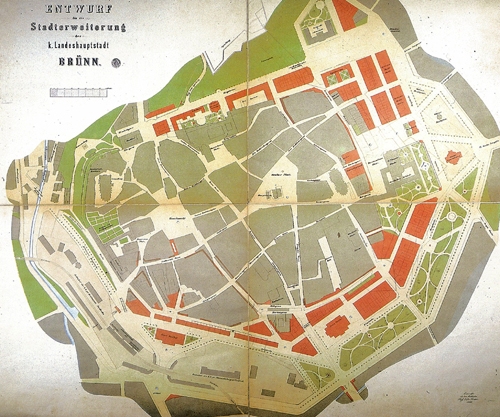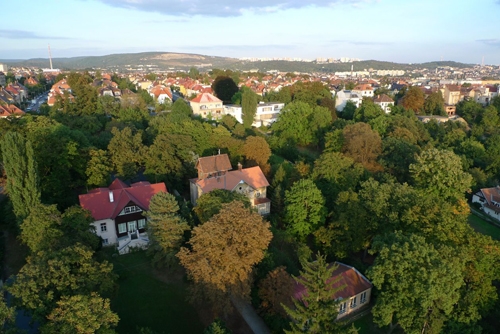The architectural shape of the city of Brno is definitively formed from the beginning of the 1860s. A German and German-Jewish population and capital predominated. Brno became an important industrial city of the Austria-Hungarian Monarchy. A typical city of the 19th century comes into being in terms of city planning and architecture. The construction of the local Ringstrasse, on the model of Vienna, is begun in 1861. Remarkable architects connected with the building of the Vienna Ringstrasse (Ludwig Förster, Theophil Hansen, Heinrich Ferstel) work out of Brno. Additional artists who permanently settle here come from Vienna and from Germany (Josef Arnold, August Prokop, Alois Prastorfer, Germano Wanderley) or work as “guests” for only one realization (Eduard van der Nüll and August Siccardsburg, Anton Hefft and Robert Raschka, Ferdinand Fellner and Hermann Helmer).
Although several urban city plans are prepared (J. Esch, 1845; J. Seifert, 1855; L. Förster, 1860; J. Lorenz, 1861) a competition for a design for expanding the city was announced at the end of 1861. The commission included three basic requirements: preserving the public promenade at Koliště park, creating spaces for military purposes and reserving a space for the construction of theatres, universities and libraries. In April 1862 the jury granted the 1st prize to the Brno architects Moritz Kellner von Brünnheim and Franz Neubauer and the 2nd prize to Josef Arnold. The victors were consequently commissioned to create a so-called combined plan which was consequently rejected by a monumental campaign due to the marked reductions to the green belt for the public. The definitive plan was submitted in February 1863, the detailed preparation of which was assigned to Franz Neubauer. The construction of the Brno Ringstrasse was initiated along the model of Paris, Barcelona and Vienna. An essential change to the definitive plan for Brno consisted of the abandonment of the principle of fluidity in favour of aesthetic aspects with an emphasis on the placement of the Evangelical church. The Brno Ringstrasse became a small version of the grand Vienna style concentrating all of the basic administrative functions within the area of the removed fortifications.
The first villa colony in Brno came into being on the slopes above Augarten (Lužánky) park between today’s Drobného streets (earlier Huterova/Huttergasse, later Sadová/Parkstrasse) and Černopolní street (Schwarzfeldstrasse). The author of the city planning idea was apparently one of the renowned architects of the Vienna Ringstrasse, Heinrich Ferstel (1828–1883). He designed the Johann Bergl Palace (1860–1863) and the Evangelical so-called Red Church (1862–1868) for the Brno Ringstrasse. Ferstel’s favourite Brno builder Josef Arnold (1824–1887) designed and realized the first structures of the oldest Brno Villa colony on the slope above Augarten (Lužánky): Karl Kaiser Villa (Černopolní/Hutter Gasse 39, 1860); his own Villa (Drobného 26, 1862), Karl Giskra villa for the lawyer and later Brno mayor in 1866–1867 (Drobného 28, 1862), the villa for the lawyers Franz and Josef Adamczik (Drobného 30 and Schodová 14, 1863; later torn down).


